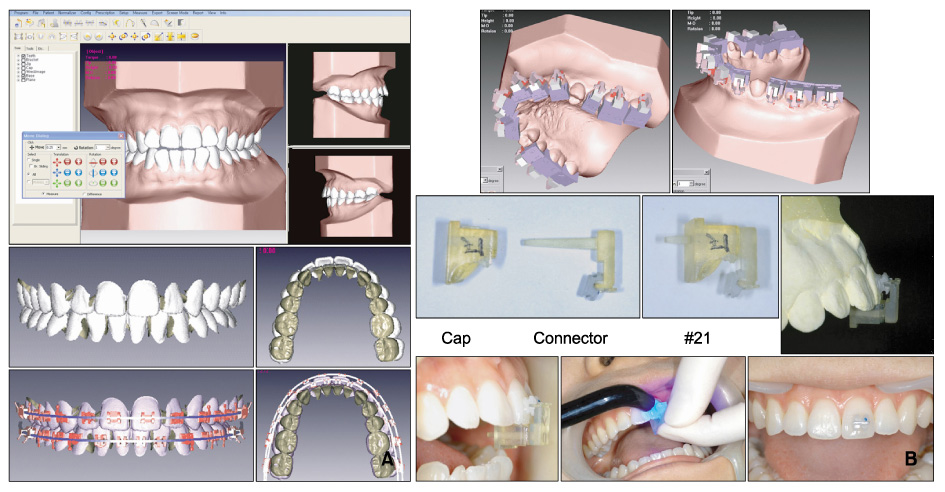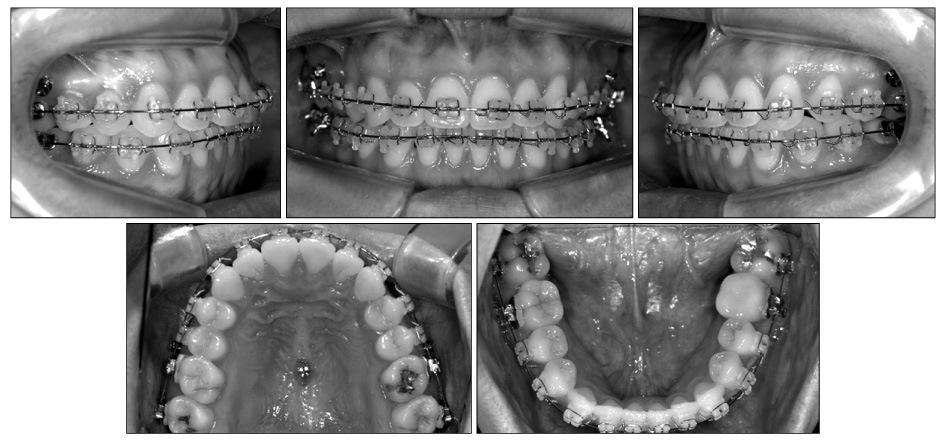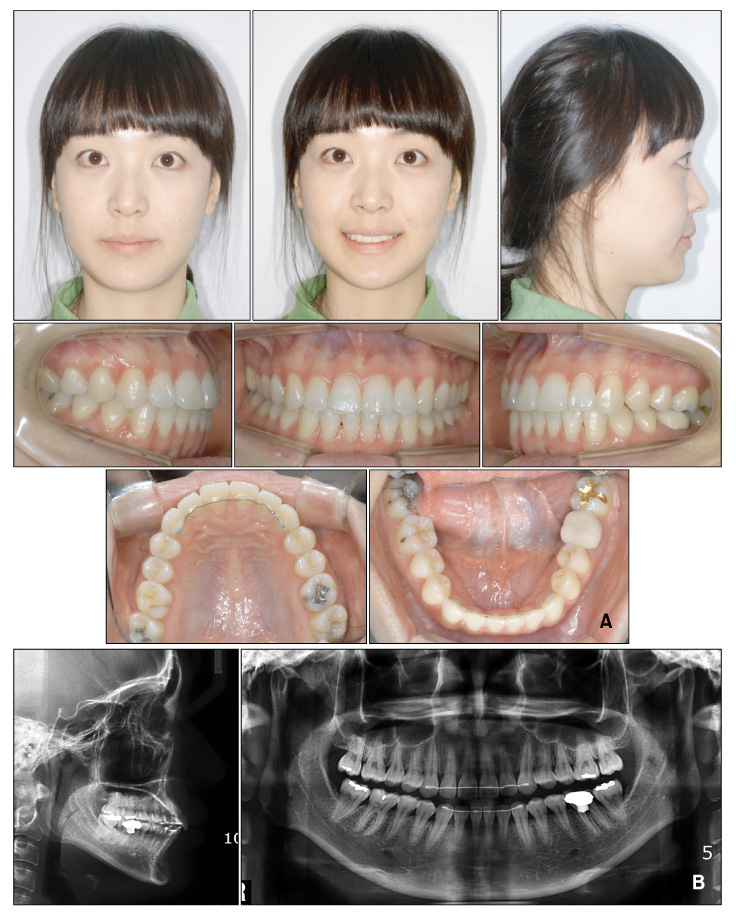Korean J Orthod.
2011 Apr;41(2):138-146. 10.4041/kjod.2011.41.2.138.
New virtual orthodontic treatment system for indirect bonding using the stereolithographic technique
- Affiliations
-
- 1Department of Orthodontics, Kooalldam Dental Hospital, Incheon, Korea.
- 2Department of Orthodontics, School of Dentistry, Seoul National University, Seoul, and Private Practice, Department of Orthodontics, Kooalldam Dental Hospital, Incheon, Korea.
- 3Department of Orthodontics, School of Dentistry, Seoul National University, Seoul, and Private Practice, Seongnam, Korea.
- 4Department of Orthodontics, School of Dentistry, Seoul National University, Seoul, and Private Practice, Suwon, Korea.
- 5Department of Orthodontics, School of Dentistry, Dental Research Institute, Seoul National University, Seoul, Korea. drwhite@unitel.co.kr
- KMID: 2274250
- DOI: http://doi.org/10.4041/kjod.2011.41.2.138
Abstract
- The purpose of this article is to introduce a new virtual orthodontic treatment (VOT) system, which can be used to construct three-dimensional (3D) virtual models, establish a 3D virtual setup, enable the placement of the virtual brackets at the predetermined position, and fabricate the transfer jig with a customized bracket base for indirect bonding (IDB) using the stereolithographic technique. A 26-year-old woman presented with anterior openbite, crowding in the upper and lower arches, and narrow and tapered upper arch, despite having an acceptable profile and balanced facial proportion. The treatment plan was rapid palatal expansion (RPE) without extraction. After 10 days of RPE, sufficient space was obtained for decrowding. After a 10-week retention period, accurate pretreatment plaster models were obtained using silicone rubber impression. IDB was performed according to the protocol of the VOT system. Crowding of the upper and lower arches was effectively resolved, and anterior openbite was corrected to normal overbite. Superimposition of the 3D virtual setup models (3D-VSM) and post-treatment 3D virtual models showed that the latter deviated only slightly from the former. Thus, the use of the VOT system helped obtain an acceptable outcome in this case of mild crowding treated without extraction. More cases should be treated using this system, and the pre- and post-treatment virtual models should be compared to obtain feedback regarding the procedure; this will support doctors and dental laboratory technicians during the learning curve.
MeSH Terms
Figure
Reference
-
1. Andrews LF. The straight-wire appliance. Br J Orthod. 1979. 6:125–143.
Article2. Mayhew MJ. Computer-aided bracket placement for indirect bonding. J Clin Orthod. 2005. 39:653–660.3. Silverman E, Cohen M. A report on a major improvement in the indirect bonding technique. J Clin Orthod. 1975. 9:270–276.4. Moin K. Indirect bonding of orthodontic attachments. Am J Orthod. 1977. 72:261–275.
Article5. Simmons MD. Improved laboratory procedure for indirectbonding of attachments. J Clin Orthod. 1978. 12:300–302.6. Thomas RG. Indirect bonding: simplicity in action. J Clin Orthod. 1979. 13:93–106.7. White LW. A new and improved indirect bonding technique. J Clin Orthod. 1999. 33:17–23.8. Sheridan JJ. The Readers' Corner. 1. Do you use indirect bonding? J Clin Orthod. 2004. 38:543–544.9. Fortini A, Giuntoli F, Franchi L. A simplified indirect bonding technique. J Clin Orthod. 2007. 41:680–683.10. Keim RG, Gottlieb EL, Nelson AH, Vogels DS 3rd. 2002 JCO study of orthodontic diagnosis and treatment procedures. Part 1. Results and trends. J Clin Orthod. 2002. 36:553–568.11. Keim RG. The indirect approach. J Clin Orthod. 2007. 41:651–652.12. White LW. An expedited indirect bonding technique. J Clin Orthod. 2001. 35:36–41.13. Alpern MC, Primus C, Alpern AH. The AccuBond system for indirect orthodontic bonding. J Clin Orthod. 2009. 43:572–576.14. Husain A, Ansari T, Mascarenhas R, Shetty S. A new approach to indirect bonding. J Clin Orthod. 2009. 43:652–654.15. Sondhi A. Efficient and effective indirect bonding. Am J Orthod Dentofacial Orthop. 1999. 115:352–359.
Article16. Sondhi A. Effective and efficient indirect bonding: The Sondhi method. Semin Orthod. 2007. 13:43–57.
Article17. Noble J, Hechter FJ, Karaiskos NE, Lekic N, Wiltshire WA. Future practice plans of orthodontic residents in the United States. Am J Orthod Dentofacial Orthop. 2009. 135:357–360.
Article18. Redmond WJ, Redmond MJ, Redmond WR. The OrthoCAD bracket placement solution. Am J Orthod Dentofacial Orthop. 2004. 125:645–646.
Article19. Ciuffolo F, Epifania E, Duranti G, De Luca V, Raviglia D, Rezza S, et al. Rapid prototyping: a new method of preparing trays for indirect bonding. Am J Orthod Dentofacial Orthop. 2006. 129:75–77.
Article20. Andrews LF. The six keys to normal occlusion. Am J Orthod. 1972. 62:296–309.
Article21. Sachdeva RC. SureSmile technology in a patient--centered orthodontic practice. J Clin Orthod. 2001. 35:245–253.22. Garino F, Garino GB. Computer-aided interactive indirect bonding. Prog Orthod. 2005. 6:214–223.23. Cho MY, Choi JH, Lee SP, Baek SH. Three-dimensional analysis of the tooth movement and arch dimension changes in Class I malocclusions treated with first premolar extractions: a guideline for virtual treatment planning. Am J Orthod Dentofacial Orthop. 2010. 138:747–757.
Article
- Full Text Links
- Actions
-
Cited
- CITED
-
- Close
- Share
- Similar articles
-
- Orthodontic treatment using indirect bonding technique in periodontitis
- Report on a case treated with lingual multibracket appliance
- A study of shear bond strength of bonded retainer according to the bonding method and type of wires
- Surgical Stent Fabrication and Clinical Application for Orthognathic Surgery Using Cone-Beam CT
- Clinical consideration of indirect bonding technique








